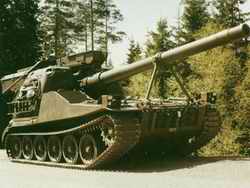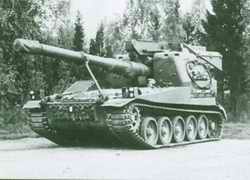| Designation: | Bandkanon 1A |
 |
|---|---|---|
| Manufacturer: | Bofors Defence AB | |
| Product type: | Armoured Vehicles | |
| Name: | Self-propelled howitzer |
The 155 mm Bandkanon 1A was developed by the now Bofors Defence (now owned by United Defense of the USA) in the late 1950s, with the first prototype completed in 1960. In 1965, the company was awarded a production contract for the vehicle worth SKr60 million. The first production vehicle was completed the following year and production continued until 1968.
The 155 mm Bandkanon 1A uses many components of the Bofors S-tank including the suspension, power pack and transmission. The S-tank has now been phased out of service with the Swedish Army. The single prototype of the Bandkanon 1A was followed by 26 production vehicles, which were deployed in northern Sweden.
In August 1988, the Defence Materiel Administration (FMV) awarded a contract to Bofors Defence for the modernisation of the Swedish Army's 155 mm Bandkanon 1As. Under the terms of the contract, Bofors Defence replaced the existing power pack with a new unit consisting of a Detroit Diesel 6V-53T six cylinder developing 290 hp coupled to a new automatic transmission developed and produced by Bofors Defence. (This power pack was the same as that installed in Strv 103B S-tanks.) The contract, the first part of which was worth SKr75 million and included training and maintenance documentation, followed Swedish Artillery trials held over a 12-month period using a prototype fitted with the new power pack.
In April 1993, the FMV awarded Bofors Defence a contract to develop and build two prototypes of the 155 mm Bandkanon 1A fitted with the Honeywell MAPS (Modular Azimuth Positioning System) and the gun interfaced with a new fire-control system, the SKER. Following successful trials of the two prototype vehicles, Bofors Defence subsequently upgraded the whole fleet to this standard.
All of these Bofors Defence 155 mm Bandkanon 1A self-propelled guns have now been taken out of service and placed in store as reserve equipment.
The hull of the 155 mm Bandkanon 1A is made of all-welded steel with the engine and transmission at the front. The driver is seated immediately in front of the turret and the all-welded steel turret is at the rear.
The power pack consists of a Detroit Diesel 6V-53T and a gas turbine geared together to a common output. The diesel is normally used all the time and the gas turbine is engaged when driving across country. The transmission consists of a Volvo torque converter coupled to a gearbox with two forward and two reverse gears (one gear is for road use and the other for cross-country). The steering system is regenerative double-differential with a hydrostatic system and steering is by handlebars on the tiller column. The power pack, complete with transmission, can be removed from the vehicle as a complete unit to facilitate replacement in the field. The cooling system for the diesel is on the right side and the cooler for the steering system on the left.
The driver, who sits slightly to the left of the vehicle's centreline, has a single-piece hatch cover in front of which is a day periscope. This can be replaced by a passive periscope for night driving.
The all-welded turret is in two halves, left and right, both of which have a door in the front and three vision blocks, two for observation to the front and one to the side of the vehicle. In the left half of the turret are the commander, gunlayer and radio operator and in the right half are the loader and 7.62 mm anti-aircraft machine gunner. Both turret halves have a single-piece hatch cover.
The hydropneumatic suspension can be locked in position when the gun is being fired to provide a more stable firing platform. The suspension either side consists of six dual rubber-tyred roadwheels with the drive sprocket at the front and the last roadwheel acting as the idler. There are no track-return rollers.
The L/50 155 mm gun weighs 4,800 kg complete with muzzle brake and replaceable liner and is 7.75 m long. The liner itself weighs 1,340 kg. The gun barrel has a pepperpot muzzle brake and a semi-automatic wedge-shaped breech block that opens downwards. When travelling, the barrel is held by a lock at the front of the hull.
The elevating mechanism is counterbalanced by a spring balancing gear mounted in the pivot of the cradle. The elevating device consists of a handwheel mounted in the left cabin, which operates a worm gear on the elevating pinion shaft. The elevating device also has an auxiliary electric motor for rapid laying between the loading and firing position. The control lever for the auxiliary motor is in the left cabin and the motor itself is in the right cabin.
The gun can be elevated by the electric motor from +2 to +38º at 5º/s. Manual elevation is from -3 to +40º. Traverse is manual, 15º left and 15º right at an elevation of above 0º and a traverse of 15º left and 4º right when the barrel is below 0º. The gun is fed from a 14-round clip. The loading device consists of a loading tray that is suspended on rollers beneath the magazine. The loading tray transports the ammunition from the magazine to the ramming position, it is then fed by a rammer built into the loading tray. The loading tray, as well as the rammer, is operated by springs that are cocked by the run-out of the gun and the movement of the loading tray. The rounds are fed to the loading tray by alternating spring-operated feeding trays, one each side of the loading tray. Maximum rate of fire is 14 rounds in 48 seconds.
The magazine itself consists of seven drop compartments, holding two rounds each, from where the rounds drop down onto the feeding trays. Both the magazine and the feeding devices are protected by armour and the two armour-plated doors on the top of the magazine, which open vertically for reloading, are operated by a single electric motor. Reloading with 14 rounds takes 2 minutes. When the magazine has been expended, the gun is elevated to an angle of +38º and the two covers on top of the magazine are opened vertically. A new clip of ammunition is fed into the magazine from an articulated ammunition hauler. The doors are closed and the gun is then ready to fire again. The complete loading sequence takes only two minutes. The first round is manually loaded, after which loading is automatic. The gunner can select either single shots or fully automatic. The gun fires a complete (for example, projectile and charge system) HE projectile weighing 48 kg to a maximum range of 25,600 m. Maximum muzzle velocity with charge 3 is 865 m/s and with charge 1 is 600 m/s. The sight has a magnification of ×4 and a 10º field of view.
In place of the normal sight a Honeywell MAPS land navigation system is installed. This system gives the gun position and the attitude of the barrel (that is, traversing, elevation and trunnion angle). This negates the requirement for surveying and alignment normally associated with bringing a gun into action and permits 'shoot and scoot' tactics.
|
||||||||||||||||||||||||||||||||||||||||
 |
 |
 |
 |
